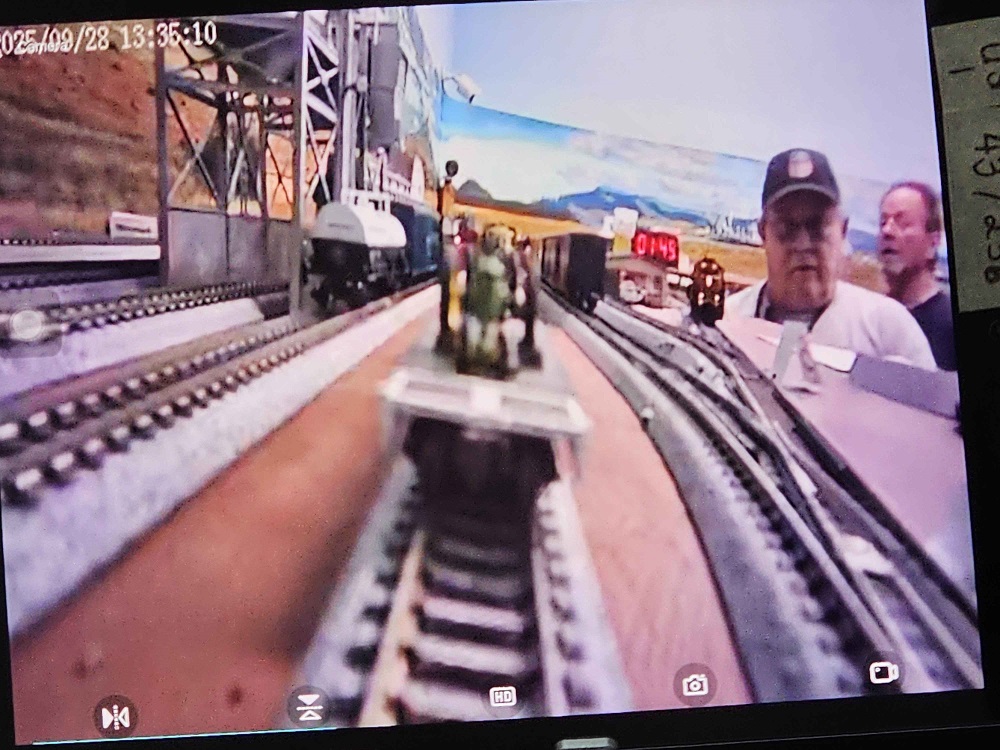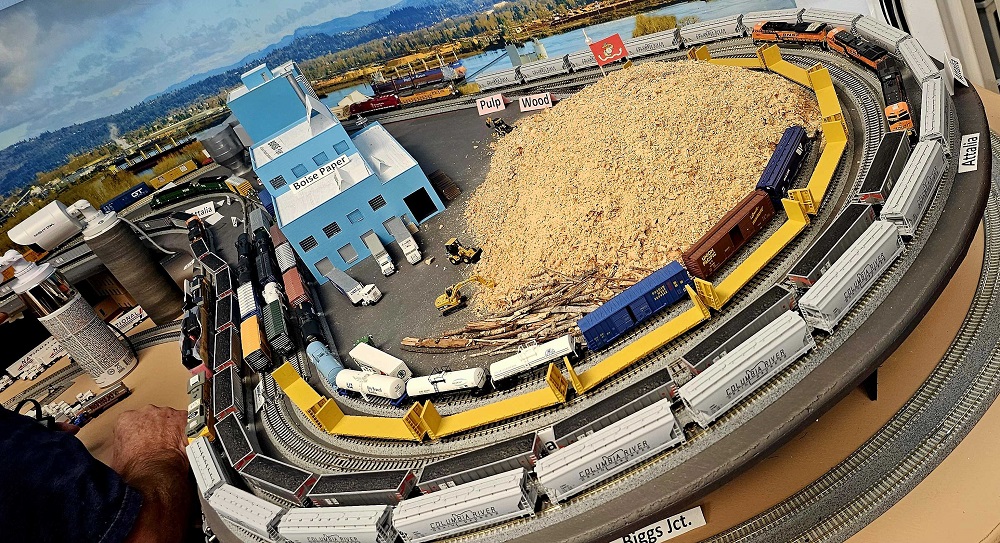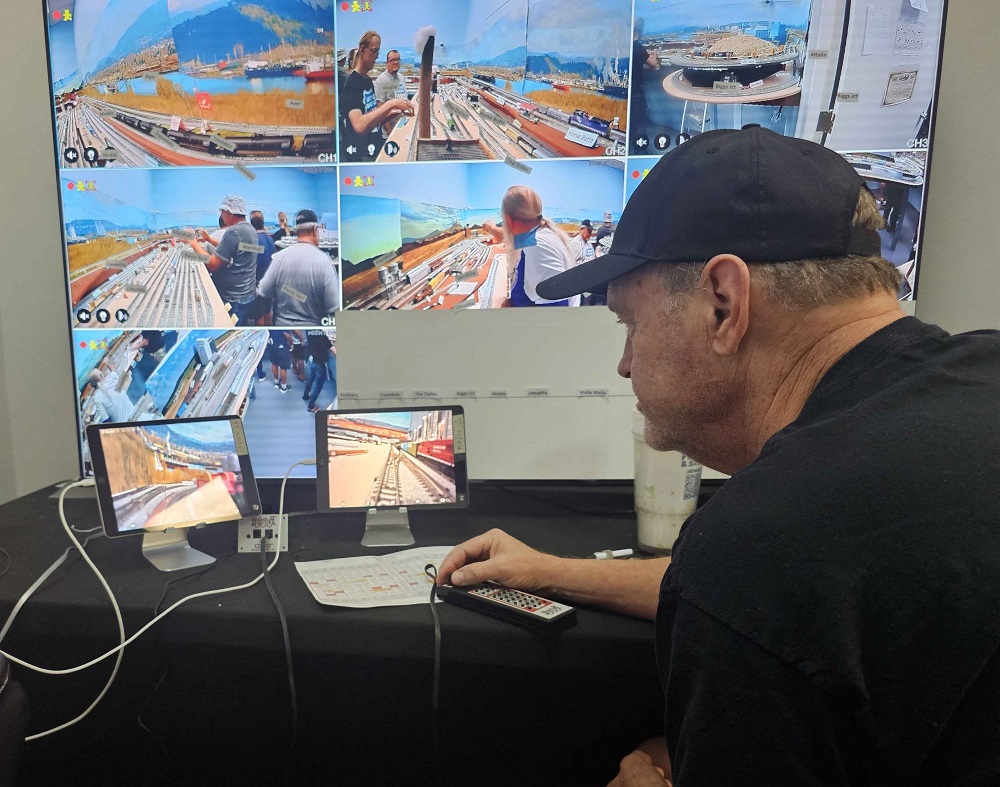OpsLog – WAZU – 9/28/2025
OpsLog – WAZU – 9/28/2025
 ne thing I’ve finally learned: There are places you shouldn’t jam coal into.
ne thing I’ve finally learned: There are places you shouldn’t jam coal into.
I suppose a qualifier is in order here.
Last LM&O session, I passed two hopper trains (loads and empties) on the smallest siding we have (way up in Harris Glen, the mountaintop where eagles soar and swamis meditate). I think we’ve done it before – if both coal movements head out at session-start, it’s natural they will meet there. But coal hoppers are tippy, the grade is steep, and the reach long. If anything goes wrong there, if a saw-by is needed, it goes sideways fast. But I slid them by, tight but right.
You’d think I’d have learned from that. But like some sort of adrenalin-junkie, I was jonesing on risk.

Shemp and JW stalk a remote train. (Photo: John C)
So my most-recent WAZU session, I was in the hot seat again, moving fast consists across the Pacific Northwest. Now, we were a man short so there was a lot of distractions. I had to roster some of the trains out, very crew-disruptive and radio-intensive. Every time I’d glace from train to location to timetable, we looked an hour-down. I was trying to dig myself out of the hole. And then came the “Temptation of Attalia”. Two trans east, a potash train and a general merchandiser. And west, a long cut of just-washed coal, still shaking off water and running a touch late. I decided on a saw-by at Attalia – the two long easties would foul for sure, but the coal could, should, might fit. After all, I think Attalia has a length of thirty-one cars. But as I gave the order, I realized that the coal had a mid-train unit too. Was this new? Was the train now longer? Would it fit?
At the desk, I watched the Attalia-cam. The two eastbounds were in (the manifest hanging out the east end). And here came the long coal, snaking in. I could watch the engineers involved chucking, one of them snapping the picture used. On the other camera, other operators were glancing over. Blood in the water. I was already coming up with contingency plans. Classically, in this situation, the coal train would drop a car or two short of the switch and the westbound potash would carry them up the line on his pilot. As soon as he found a turnout, he’d shove the cars clear and then proceed. I’d probably order the manifest to follow. Then the coal could back up, fetch up his cars and off he’d go. That’s the classic, anyway. Whether I could give these instructions over our busy radios or not was riding in my mind. I’d probably just tell them to work it out on the ground and take the shit that came my way for that.
But the coal slid in. Just barely. I was tensely watching the cameras, knowing we were running out of room, when that last car slid in.
And that’s the narrow line between being considered a sharp dispatcher and a guy who blogs his own obit.

Great Moments in Lucky Dispatching. One of these days, this won’t work. (Photo: Coal-Lump Jungck)

Doc Andy finally gets to run his layout remote – a lot of effort went into making this moment (Photo: John C)
Anyway, all said and done, the session ran really well. While I was noting hour delays in the middle of the line (between Hinkle and Pasco yards), the yard guys and switch crews worked fast, gaining back the time. And since we were working to clear their final destination tracks (and the crews responded quickly to hostler calls) we got most of the trains back on their timetables. We ended pretty much at midnight and everyone was positive in the debrief.
President Shannon came in to boost our low crew count, listening carefully on the walk through and running just like a regular. His assistance was appreciated and we hope he’ll come back (do I need to buy him another six pack?). The yards ran nice (other than the US Army occupying Pasco, but that was a misaligned turnout, not an executive order). And speaking of the the US 2 Army train, John did a great job – he has to do minor switching at Umatilla (which used to be handled by a lot of radio chatter or through-the-door bellowing). John just got off his not-lazy ass, walked in and quietly did it himself, on site. People lined switches when asked and the team worked well.
There was one crew (with a two-letter call sign) that worked Pasco yard as a trailing point move, but we’ll let it slide. After all, I know the guy carries a nine iron with him.
And, of course, the pizza was good. So thanks to Doc Andy for hosting and the continuing improvements that he makes. It all makes for a great session.

Working the stacks at Cheney (Photo: John C)
